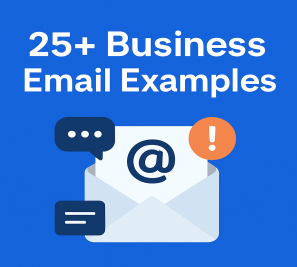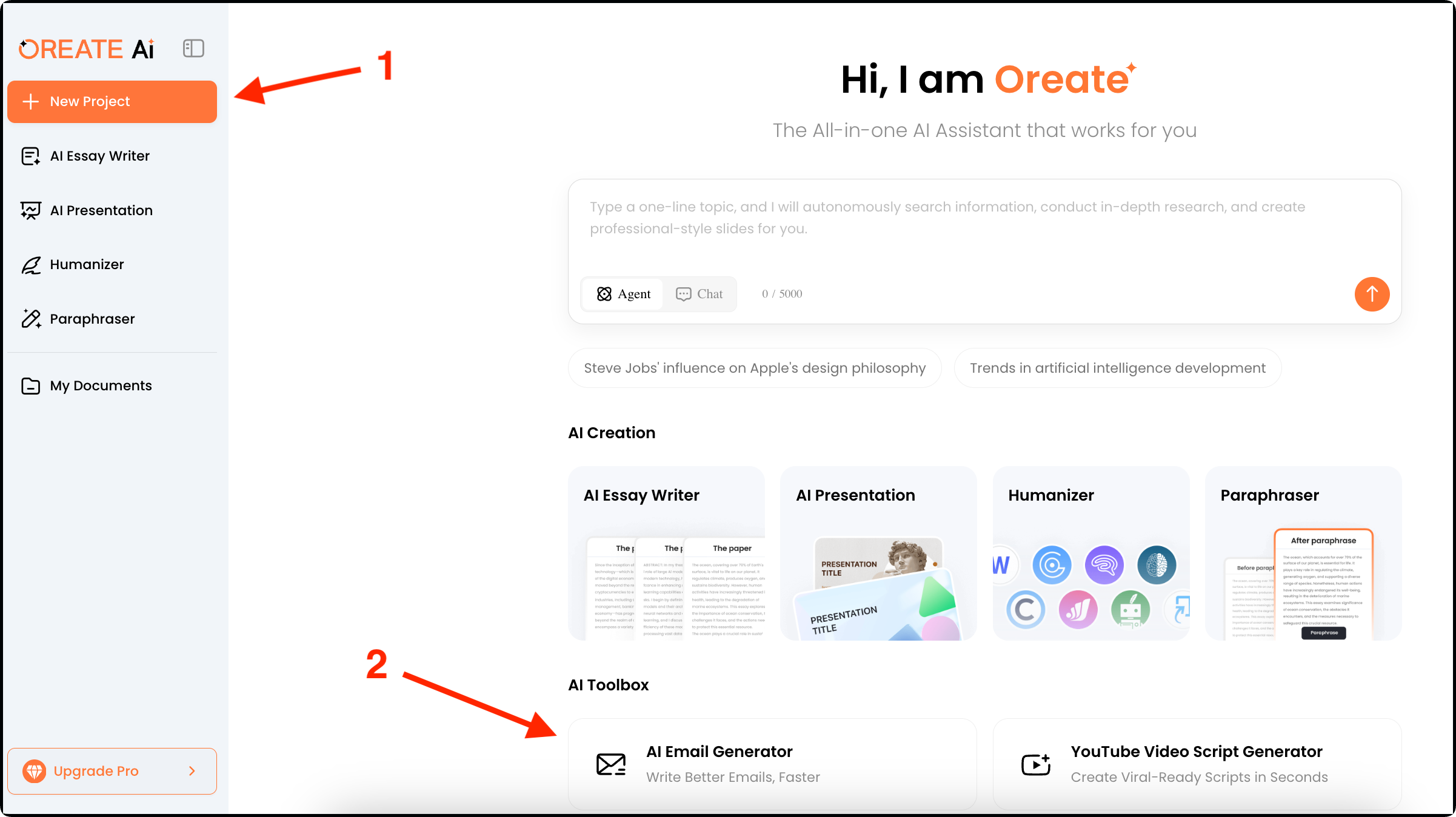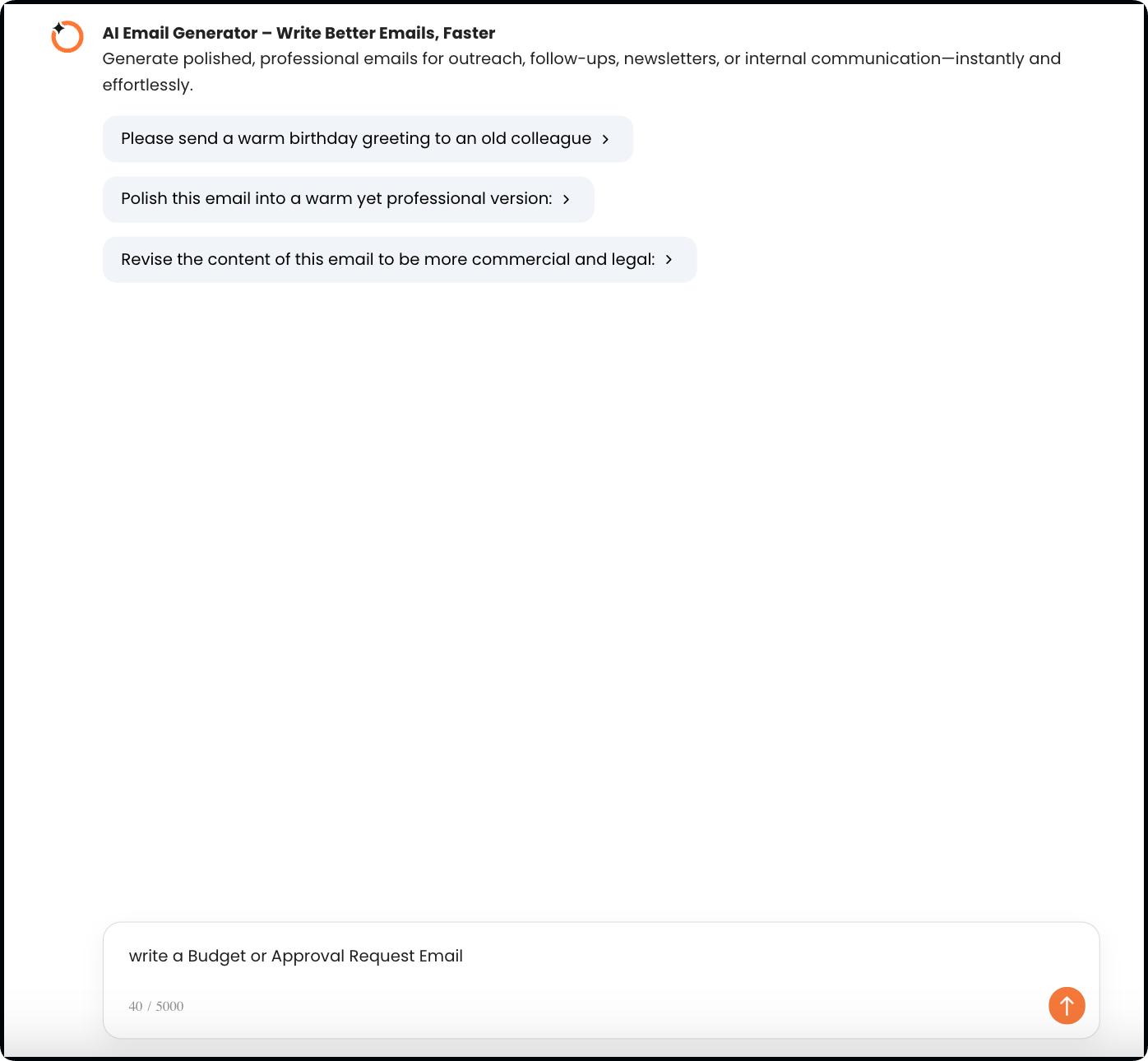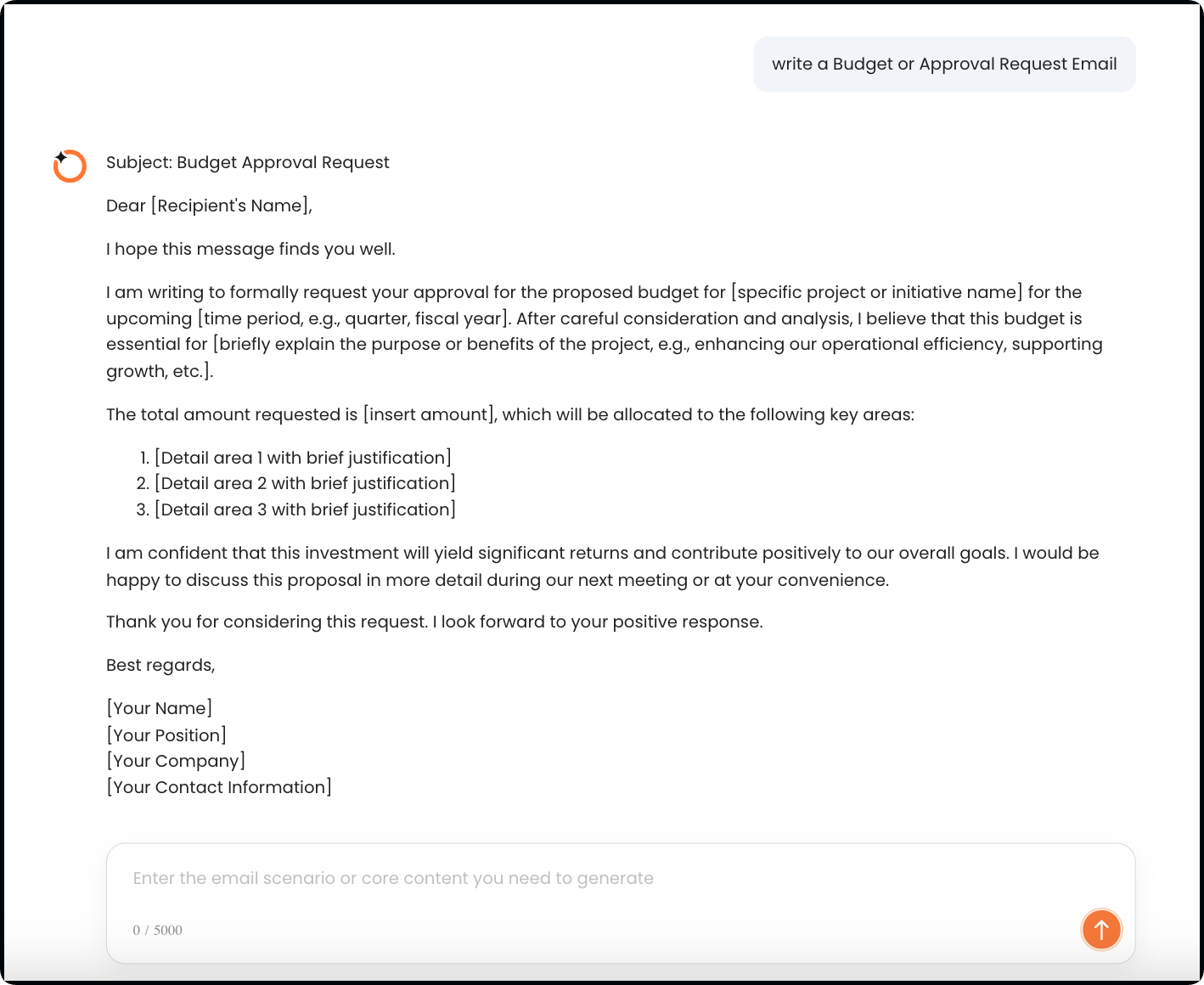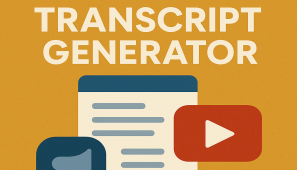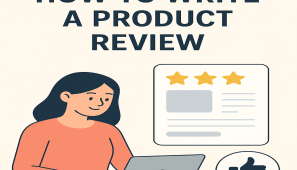Crafting compelling professional emails is crucial in today’s digital landscape. With a return on investment that could quadruple what you spend, effective email templates can make all the difference.
You want to impress your clients and stand out in a crowded inbox. A well-structured business email can help you achieve just that.
(Click the picture to try Oreate AI Email Generator⬆️)
By using the right format and writing tips, you can create impactful emails that drive results. In this article, we’ll provide you with 25+ business email examples and templates to help you get started.
Key Takeaways
- Learn how to craft a compelling professional email format
- Discover the importance of effective email templates
- Get access to 25+ business email examples and templates
- Improve your email writing skills with pro tips
- Boost your email marketing ROI with well-structured emails
Why Professional Business Emails Matter?
In today’s fast-paced business world, the importance of well-crafted professional emails cannot be overstated. As a business professional, you understand that email is a crucial aspect of business communication, and composing emails can be time-consuming, especially when writing similar messages repeatedly.
Impact on Business Relationships
Professional business emails significantly impact your business relationships. A well-written email can help establish trust, convey your message clearly, and foster a positive impression. On the other hand, a poorly written email can lead to misunderstandings and damage your professional reputation.
Email as a Reflection of Your Brand
Your business emails are a reflection of your brand’s image and values. A professional email demonstrates your attention to detail and commitment to quality. It’s essential to ensure that your emails align with your brand’s voice and tone to maintain consistency across all your communication channels.
The ROI of Well-Crafted Business Communication
Investing time and effort into crafting professional business emails can yield a significant return on investment. By improving your email writing skills, you can enhance your business relationships, increase productivity, and ultimately drive business growth.
| Email Aspect | Impact on Business | Best Practice |
|---|---|---|
| Professionalism | Establishes trust and credibility | Use a formal greeting and signature |
| Clarity | Ensures effective communication | Be concise and clear in your message |
| Brand Consistency | Reinforces brand identity | Use consistent tone and formatting |
Essential Elements of a Professional Business Email Format
A well-structured business email is the backbone of any successful business communication strategy. To ensure your emails are effective and professional, there are several key elements to consider.
1. Subject Line Best Practices
The subject line is the first thing your recipient sees, making it crucial for getting your email opened. Keep it concise, clear, and relevant to the content of your email. Avoid using spam triggers like “Free” or excessive punctuation.
2. Professional Greeting Options
Starting your email with a professional greeting sets the tone for the rest of the message. Use greetings like “Dear [Name],” “Hello [Name],” or “Good morning/afternoon [Name].” Make sure to address the recipient by name if possible.
3. Body Structure and Paragraphing
The body of your email should be well-structured and easy to read. Use short paragraphs, clear headings, and bullet points when listing multiple items. This makes your email more digestible and helps the recipient quickly understand your message.
4. Closing and Signature Block Design
End your email with a professional closing like “Best regards,” “Sincerely,” or “Thank you.” Your signature block should include your name, title, company, and contact information. This provides the recipient with an easy way to get back in touch with you.
| Email Element | Best Practice | Example | |||
|---|---|---|---|---|---|
| Subject Line | Concise and relevant | “Meeting Request for Project Discussion” | |||
| Greeting | Professional and personalized | “Dear [Recipient’s Name]” | |||
| Body | Clear and structured | Short paragraphs and bullet points | |||
| Closing | Professional | “Best regards” | |||
| Signature | Includes your name at least | “[Your Name][Your Title][Company Name][Contact Information]” |
Type 1. Introduction Email Templates
Effective introduction emails can open doors to new business opportunities and strengthen professional networks. Whether you’re introducing yourself to a new client, a new employee to your team, or reaching out to a potential business partner, a well-crafted introduction email is crucial.
1. Introducing Yourself to a New Client
When introducing yourself to a new client, your email should be professional, concise, and personalized. Start with a formal greeting, followed by a brief introduction that includes your name, your company, and the purpose of your email.
Template:
Subject: Introduction – [Your Name], [Your Position] at [Company]
Dear [Client Name],
I hope this message finds you well. My name is [Your Name], and I recently joined [Company Name] as [Your Position]. I’ll be your point of contact for [project, account, or service], and I’m excited to work with you.
A little about my background: I have experience in [brief relevant experience or expertise], and I am committed to ensuring that your experience with [Company Name] is seamless and productive.
Please feel free to reach out at any time if you have questions, feedback, or specific goals you’d like to discuss. I look forward to collaborating with you and helping you achieve [specific client objective or outcome].
Thank you, and I’m excited to get started.
Best regards,
[Your Name]
2. New Employee Introduction
Introducing a new employee to the team is vital for creating a welcoming environment. Your email should include the new employee’s name, role, and a brief background.
Template:
Subject: Introducing [Your Name] – New [Your Position] at [Company]
Dear Team,
I am excited to join [Company Name] as [Your Position] and wanted to take a moment to introduce myself. I bring experience in [brief relevant experience or expertise] and look forward to contributing to [team/department goal or project].
I’m eager to collaborate with all of you, learn from your expertise, and support our shared objectives. Please feel free to reach out to me at any time—I’d love to connect and get to know everyone.
Looking forward to working with you all!
Best regards,
[Your Name]
3. Introduction to a Potential Business Partner
When reaching out to a potential business partner, your introduction email should highlight the potential for mutual benefit. Be clear about your intentions and show that you’ve done your research on their company.
Template:
Subject: Introduction – [Your Name], [Your Position] at [Company]
Dear [Partner Name],
I hope this message finds you well. My name is [Your Name], and I am [Your Position] at [Company Name]. I wanted to reach out to introduce myself and explore potential opportunities for collaboration between our organizations.
At [Company Name], we specialize in [brief description of services/products or expertise], and I believe there may be synergies that could benefit both of our businesses. I would be delighted to schedule a time to discuss this further at your convenience.
Thank you for your time and consideration. I look forward to connecting with you.
Best regards,
[Your Name]
4. Team Introduction to New Project Stakeholders
When introducing your team to new project stakeholders, provide a brief overview of each team member’s role and expertise. This helps stakeholders understand who they’ll be working with and builds confidence in your team’s capabilities.
Template:
Subject: Introducing Our Team for [Project Name]
Dear [Stakeholder Name],
I hope this message finds you well. I am pleased to introduce the team that will be supporting [Project Name] at [Company Name]:
- [Team Member 1 Name] – [Role/Responsibility]
- [Team Member 2 Name] – [Role/Responsibility]
- [Team Member 3 Name] – [Role/Responsibility]
Our team brings experience in [brief relevant expertise], and we are committed to ensuring the success of this project. We look forward to collaborating with you and keeping open lines of communication throughout the process.
Please feel free to reach out to any of us with questions or updates. We are excited to work together and achieve great results.
[Your Name]| Email Type | Purpose | Key Elements |
|---|---|---|
| New Client Introduction | Establish a professional connection | Personalized greeting, brief introduction, purpose |
| New Employee Introduction | Welcome new team member | Employee’s name, role, background |
| Potential Business Partner Introduction | Explore potential collaboration | Mutual benefit, clear intentions, research on their company |
| Team Introduction to Stakeholders | Build confidence in your team | Team members’ roles, expertise |
Our template library has over plenty of business email templates to help you with various types of email outreach, including introduction emails. These templates are designed to save you time and ensure your emails are effective and professional.
(Click the picture to try Oreate AI Email Generator⬆️)
Type 2. Request Email Examples
Request emails are a vital tool in the business world, enabling you to ask for what you need effectively. Whether you’re requesting a meeting, information, resources, or budget approval, a well-crafted email can make all the difference in achieving your goals.
1. Meeting Request Templates
When requesting a meeting, it’s essential to be clear about the purpose and expected outcomes. Use a template that includes the proposed date, time, location, and agenda to help the recipient prepare.
Template:
Subject: Meeting Request – [Topic]
Dear [Recipient Name],
I hope this message finds you well. I would like to schedule a meeting to discuss [topic or purpose], as your input will be invaluable for [specific goal or outcome].
Could you please let me know your availability over the next few days? I anticipate the discussion will take approximately [duration]. I am happy to accommodate your schedule.
Thank you for your time and consideration. I look forward to our conversation.
Best regards,
[Your Name]
2. Information Request Examples
When requesting information, be specific about what you need and why. This helps the recipient provide a more accurate and relevant response.
Template:
Subject: Request for Information – [Topic]
Dear [Recipient Name],
I hope you are doing well. I am reaching out to request information regarding [specific information needed]. Access to this information will be crucial for [purpose, project, or decision-making].
Could you please provide [details, documents, or data] by [specific date, if applicable]? Your support will be greatly appreciated and will help ensure timely progress.
Thank you in advance for your assistance.
Best regards,
[Your Name]
3. Resource Request Formats
Requesting resources, such as equipment or personnel, requires a clear justification of why these resources are necessary. Use a format that outlines the benefits and potential outcomes of granting the request.
Template:
Subject: Request for Resources – [Project/Task Name]
Dear [Recipient Name],
I am writing to request [specific resource(s)] to support [project or task]. Having these resources will enable us to [explain benefit, improve efficiency, or achieve key milestone].
Please let me know if you need additional details or documentation to facilitate this request. Your support in providing these resources will be instrumental to the success of the project.
Thank you for your consideration.
Best regards,
[Your Name]
4. Budget or Approval Request Emails
When requesting budget approval, provide a detailed breakdown of the costs and expected return on investment. This helps decision-makers understand the value of their investment.
Template:
Subject: Request for Budget/Approval – [Project/Initiative]
Dear [Recipient Name],
I hope you are well. I am seeking approval for a budget of [amount] to support [project or initiative]. This allocation will cover [brief breakdown of expenses] and ensure that we can achieve [expected outcome or business benefit].
Your timely approval will allow us to proceed as planned and deliver results efficiently. Please let me know if you require further details or supporting documentation to make a decision.
Thank you very much for your time and consideration. I look forward to your approval.
Best regards,
[Your Name]
| Email Type | Purpose | Key Elements |
|---|---|---|
| Meeting Request | Schedule a meeting | Date, Time, Location, Agenda |
| Information Request | Obtain specific information | Clear description of the information needed |
| Resource Request | Acquire necessary resources | Justification, Benefits, Potential outcomes |
| Budget/Approval Request | Secure budget approval | Detailed breakdown, Expected ROI |
(Click the picture to try Oreate AI Email Generator⬆️)
Effective email templates can significantly improve customer support teams’ results and customer satisfaction by increasing response times. By using the templates and examples provided above, you can enhance your business communication and achieve your goals more efficiently.
Type 3. Follow-Up Email Templates
In the world of business, a well-crafted follow-up email can be the difference between a successful connection and a missed opportunity. Effective follow-up emails help you re-establish communication, build on previous conversations, and move closer to your goals.
1. After a Meeting or Call
After meeting or speaking with someone, a follow-up email can help solidify the discussion and next steps. Use this template to reiterate the key points and show your enthusiasm for moving forward.
Template:
Subject: Thank You for the Meeting – [Topic]
Dear [Recipient Name],
Thank you for taking the time to meet with me today regarding [topic]. I truly appreciate your insights and the opportunity to discuss [specific points].
As a follow-up, [brief summary of next steps, action items, or agreed points]. Please let me know if I missed anything or if there are additional items we should address.
I look forward to continuing our collaboration and achieving the objectives we discussed.
Best regards,
[Your Name]
2. Sales Follow-Up Examples
When following up on a sales lead, your email should be concise, personalized, and relevant. Use this template to check in with potential clients and provide additional value.
Template:
Subject: Following Up – [Product/Service Name]
Dear [Recipient Name],
I hope you are doing well. I wanted to follow up on our recent conversation regarding [product/service]. I’d be happy to provide further details, answer questions, or schedule a demo to demonstrate how [product/service] can help [specific benefit].
Please let me know a convenient time for a discussion. I look forward to exploring how we can support your goals.
Best regards,
[Your Name]
3. Interview Follow-Up Templates
After an interview, a follow-up email can help you stay top of mind and demonstrate your interest in the position. Use this template to thank the interviewer and reiterate your qualifications.
Template:
Subject: Thank You – [Position Name] Interview
Dear [Interviewer Name],
Thank you again for taking the time to speak with me about the [Position Name] role at [Company Name]. I greatly enjoyed learning more about the team and the exciting projects underway.
I am very enthusiastic about the opportunity to contribute and believe my experience in [specific skills or relevant experience] aligns well with your needs. Please feel free to reach out if you need any additional information or references.
I truly appreciate your time and consideration and look forward to the possibility of joining your team.
Best regards,
[Your Name]
4. Networking Event Follow-Ups
After meeting someone at a networking event, a follow-up email can help you build on the initial connection. Use this template to reference your conversation and propose a next step.
Template:
Subject: Great Connecting at [Event Name]
Dear [Contact Name],
It was a pleasure meeting you at [Event Name] and learning more about [topic or their role]. I especially enjoyed our conversation about [specific point or shared interest].
I would love to stay in touch and explore potential opportunities for collaboration or knowledge sharing. Please feel free to connect with me on [LinkedIn/email] or let me know a convenient time to continue our discussion.
Looking forward to staying connected.
Best regards,
[Your Name]
Type 4. Job & HR Related Email Templates
The use of email templates in HR contexts ensures that all team members receive uniform information, which is crucial for maintaining consistency and professionalism within an organization.
(Click the picture to try Oreate AI Email Generator⬆️)
1. Job Application & Inquiry Email
When it comes to job applications and inquiries, having a well-structured email template can make a significant difference. It not only presents the applicant in a professional light but also makes it easier for the HR department to process the applications efficiently.
Template:
Subject: Application for [Position Name] – [Your Name]
Dear [Hiring Manager’s Name],
I hope this message finds you well. I am writing to express my interest in the [Position Name] role at [Company Name]. With [brief summary of relevant experience, skills, or achievements], I am confident in my ability to contribute effectively to your team.
Please find my resume attached for your review. I would be grateful for the opportunity to discuss how my background and skills align with the needs of [Company Name].
Thank you very much for your time and consideration. I look forward to your response.
Best regards,
[Your Name]
2. Interview-Related Email
Interview-related emails, whether for scheduling, follow-up, or thank-you notes, are critical in maintaining a positive relationship with potential employees. Using templates for these emails can help ensure that all necessary information is conveyed promptly and professionally.
Template:
Subject: Interview Availability – [Position Name]
Dear [Interviewer/HR Name],
Thank you for considering me for the [Position Name] position at [Company Name]. I am available for an interview on [specific dates/times] and will gladly adjust to fit your schedule if needed.
Please let me know if there are any materials or information you would like me to prepare in advance. I appreciate your time and look forward to speaking with you.
Best regards,
[Your Name]
3. Employee Onboarding & Introduction Email
Once an applicant is hired, onboarding and introduction emails play a vital role in integrating them into the team. These emails should include essential information about the role, expectations, and company culture.
Template:
Subject: Introduction – [Your Name], New [Position Name]
Dear Team,
I am thrilled to join [Company Name] as [Position Name] and wanted to take a moment to introduce myself. My experience includes [brief relevant experience, skills, or achievements], and I am eager to contribute to [team/project objectives].
I look forward to collaborating with all of you and learning from your expertise. Please feel free to reach out—I would love to connect individually in the coming weeks.
Best regards,
[Your Name]
4. HR Notifications & Requests
HR notifications and requests are a regular part of HR operations, covering a range of topics from policy updates to benefits information. Using templates for these communications can help ensure clarity and consistency.
Template:
Subject: [Notification/Request Topic]
Dear [HR Contact Name],
I am writing to [notify/request] regarding [specific HR matter, e.g., leave, document submission, benefits clarification]. [Include relevant details, dates, or attachments as needed.]
Please let me know if any additional information is required to process this request. I sincerely appreciate your assistance and guidance.
Best regards,
[Your Name]
(Click the picture to try Oreate AI Email Generator⬆️)
Type 5. Rejection and Decline Email Templates
Delivering bad news is never easy, but having a well-crafted rejection email template can make the process less painful for both parties. Rejection emails are a crucial part of business communication, and having a template can make it easier to deliver the news.
When you’re faced with the task of rejecting a job applicant, declining a business partnership, or turning down a sales proposal, it’s essential to do so in a professional and respectful manner. Here are some examples of rejection and decline email templates that can guide you through these challenging situations.
1. Job Application Rejection Email
Rejecting a job applicant requires tact and sensitivity. A well-crafted rejection email should acknowledge the applicant’s interest and thank them for their time.
Template:
Subject: Update on Your Application – [Position Name]
Dear [Candidate Name],
Thank you very much for your interest in the [Position Name] role at [Company Name] and for sharing your background with us.
After careful consideration, we have decided to proceed with another candidate whose experience more closely aligns with the position requirements. This decision was not easy, as we received many strong applications, including yours.
We sincerely appreciate the time and effort you invested in the application process and encourage you to apply for future openings that match your skills and experience. We wish you every success in your career endeavors.
Best regards,
[Your Name]
2. Partnership/Collaboration Decline Email
When declining a potential business partnership or collaboration, it’s crucial to maintain a positive tone.
Template:
Subject: Collaboration Opportunity – [Company Name]
Dear [Contact Name],
Thank you for reaching out and exploring the possibility of collaborating with [Your Company]. After careful consideration, we have decided not to move forward with this opportunity at this time.
We greatly value your interest and professionalism, and hope there may be an opportunity to work together in the future. Please do stay in touch, and we wish you continued success in your initiatives.
Best regards,
[Your Name]
3. Sales/Service Proposal Rejection Email
Rejecting a sales or service proposal requires a balance between being direct and maintaining a positive relationship. Consider the following template:
| Component | Description |
|---|---|
| Greeting | Personalized greeting |
| Appreciation | Thank the proposer for their effort |
| Decision | Clearly state the rejection |
| Closure | End on a positive note, leaving room for future opportunities |
Template:
Subject: Proposal Response – [Product/Service Name]
Dear [Salesperson/Company Name],
Thank you for submitting your proposal regarding [product/service]. We have reviewed it carefully and, after consideration, have decided not to proceed at this time.
We appreciate the effort and detail you provided and will keep your information on file should our needs change in the future. Thank you again for your time, and we wish you continued success.
Best regards,
[Your Name]
4. Event/Invitation Decline Email
Declining an event invitation should be done graciously.
Template:
Subject: Thank You for the Invitation – [Event Name]
Dear [Organizer Name],
Thank you very much for inviting me to [event name] on [date]. Unfortunately, I am unable to attend due to [brief reason if appropriate, e.g., prior commitments].
I truly appreciate the invitation and hope the event is a great success. I look forward to staying connected and participating in future opportunities.
Best regards,
[Your Name]
By using these templates, you can ensure that your rejection and decline emails are handled professionally, maintaining the integrity of your business relationships even in challenging situations.
(Click the picture to try Oreate AI Email Generator⬆️)
Type 6. Business Announcement Email Examples
Whether you’re launching a new product or notifying employees about policy changes, a business announcement email is essential. These emails serve as a formal channel to share important updates with your stakeholders, including customers, employees, or investors.
1. New Product or Service Announcements
When announcing a new product or service, your email should highlight its key features and benefits. Use a clear subject line and introduction to grab the reader’s attention.
Template:
Subject: Exciting News – Introducing [Product/Service Name]
Dear [Recipient Name],
We are thrilled to announce the launch of our new [product/service], crafted to . This [innovation/product/service] is designed to [explain value proposition briefly].
Discover more about its features and benefits here: [link or attachment]. We would love to hear your feedback and hope you enjoy the advantages of [product/service name].
Thank you for your continued support.
Best regards,
[Your Name]
2. Company Changes Notifications
When notifying stakeholders about company changes, such as mergers, acquisitions, or leadership changes, transparency is key. Your email should clearly explain the reasons behind the change and its impact on the business.
Template:
Subject: Important Update from [Company Name]
Dear [Recipient Name],
We would like to inform you about recent developments at [Company Name]. [Briefly describe the change, e.g., leadership updates, restructuring, relocation].
These changes are part of our commitment to [goal, e.g., enhancing services, improving efficiency, supporting growth]. Should you have any questions or require further clarification, please do not hesitate to reach out.
Thank you for your understanding and continued support.
Best regards,
[Your Name]
3. Event Announcement Templates
Event announcement emails are used to invite stakeholders to conferences, webinars, or other business events. Your email should include essential details such as date, time, location, and registration information.
Template:
Subject: You’re Invited – [Event Name] on [Date]
Dear [Recipient Name],
We are excited to invite you to [Event Name], taking place on [date] at [location/online platform]. This event will feature [key highlights, speakers, or activities], offering a valuable opportunity to [network/learn/celebrate].
Reserve your spot by RSVPing here: [link or instructions]. We look forward to your participation and sharing this experience with you.
Best regards,
[Your Name]
4. Policy Update Communications
When updating your company’s policies, it’s crucial to communicate these changes effectively to your employees. Your email should clearly outline the updated policies, the reasons behind the changes, and any actions required from employees.
Template:
Subject: Action Required – Updated [Policy Name]
Dear [Recipient Name],
We would like to inform you of an important update to our [policy name], effective [date]. The update includes [brief summary of changes] and is intended to [explain purpose, e.g., improve compliance, enhance safety, clarify procedures].
Please review the updated policy here: [link or attachment]. If you have any questions or need further clarification, contact [HR or relevant department].
Thank you for your attention and cooperation.
Best regards,
[Your Name]
By following these guidelines and examples, you can craft effective business announcement emails that engage your stakeholders and convey your message clearly. Remember, knowing how to write a business email is crucial for making a positive impact on your audience.
Type 7. Sales and Marketing Email Templates
In the realm of sales and marketing, email templates play a pivotal role in streamlining communication and enhancing customer engagement. By utilizing well-crafted email templates, you can significantly improve your outreach efforts and drive better results.
1. Cold Outreach Examples
Cold outreach emails are your first point of contact with potential clients. To make a strong impression, your email should be personalized and relevant.
Template:
Subject: Helping [Recipient’s Company] Achieve [Specific Goal]
Dear [Recipient Name],
I hope this message finds you well. I’m [Your Name] from [Your Company], and we specialize in [brief description of product/service]. We help companies like yours [solve specific problem or achieve measurable goal].
I’d love to schedule a short call to discuss how we can support [Recipient’s Company] in achieving [specific benefit]. Are you available for a 15-minute conversation next week?
Thank you for your time, and I look forward to connecting.
Best regards,
[Your Name]
2. Promotional Email Formats
Promotional emails are designed to promote your products or services. Effective promotional email formats include eye-catching subject lines, engaging visuals, and concise body content. Use bold text to highlight special offers or promotions. Make sure your email is mobile-friendly, as a significant portion of your audience will likely read it on their mobile devices.
Template:
Subject: Unlock the Benefits of [Product/Service] – Special Offer Inside!
Dear [Recipient Name],
We’re excited to introduce [product/service], designed to [key benefit]. For a limited time, enjoy [discount, bonus, or incentive] when you [take action, e.g., sign up, purchase].
Don’t miss this opportunity to . Click here to claim your offer today: [link].
Best regards,
[Your Name]
3. Special Offer Announcements
Creating a buzz around special offers can drive sales and increase customer loyalty. Your email template should clearly communicate the offer, include a sense of urgency, and guide the reader on how to redeem the offer. Use limited-time language to encourage prompt action.
Template:
Subject: Exclusive Offer – [Product/Service Name]
Dear [Recipient Name],
We are thrilled to present an exclusive offer on [product/service]! From [start date] to [end date], enjoy [specific offer details, e.g., 20% off, free trial, bonus gift].
Seize this opportunity to [solve a problem or gain benefit]. Claim your offer here before it expires: [link].
Best regards,
[Your Name]
4. Re-engagement Campaign Templates
Re-engagement campaigns are crucial for reconnecting with inactive customers. Your template should be designed to rekindle interest by offering personalized content, exclusive deals, or feedback requests. Use a friendly tone to make your customers feel valued and appreciated.
Template:
Subject: We Miss You – Special Offer Inside!
Dear [Recipient Name],
It’s been a while since we last connected, and we’d love to welcome you back! To help you get started again, enjoy [special offer, discount, or incentive] on [product/service].
Rediscover how [product/service] can help you [solve problem or achieve benefit]. Click here to reconnect and claim your offer: [link].
We look forward to having you back!
Best regards,
[Your Name]
By incorporating these sales and marketing email templates into your strategy, you can enhance your business communication examples and achieve your marketing goals more effectively.
(Click the picture to try Oreate AI Email Generator⬆️)
Common Business Email Mistakes to Avoid
Crafting the perfect business email is crucial, but it’s equally important to avoid common pitfalls. When communicating professionally, the format and content of your email can significantly impact how your message is received.
1. Grammar and Spelling Errors
One of the most critical aspects of a professional business email format is ensuring that it is free from grammar and spelling errors. A single mistake can undermine your credibility and make your message appear less professional.
2. Tone Missteps and Emotional Language
The tone of your email is just as important as its content. Avoid using emotional language or tone missteps that can be misinterpreted. Instead, opt for a friendly yet professional tone that aligns with your brand voice.
3. Formatting Faux Pas
Poor formatting can make your email difficult to read. Use clear headings, concise paragraphs, and proper formatting to ensure your email is visually appealing.
4. Attachment and Link Errors
When including attachments or links, double-check that they are correct and functional. Broken links or missing attachments can lead to frustration and lost opportunities.
| Common Mistake | Impact | Solution |
|---|---|---|
| Grammar and Spelling Errors | Undermines credibility | Proofread carefully |
| Tone Missteps | Leads to misinterpretation | Use professional tone |
| Formatting Issues | Makes email hard to read | Use clear formatting |
| Attachment/Link Errors | Causes frustration | Double-check attachments/links |
(Click the picture to try Oreate AI Email Generator⬆️)
By avoiding these common mistakes, you can ensure that your business emails are effective and professional, helping you to build stronger relationships with your clients and colleagues.
How to Automate Emails for Efficient Business Communication?
As businesses grow, email automation can significantly enhance efficiency in their daily operations. By leveraging automation, you can streamline your email communication, reduce manual errors, and save time.
(Click the picture to try Oreate AI Email Generator⬆️)
1. Content and Template Tools
Utilizing templates can greatly simplify your email management. Tools like the Oreate AI Email Generator allow you to create and polish personalized emails, ensuring timely communication with your clients or team members. This not only improves productivity but also enhances the consistency of your business email example.
Using it is quite simple, even for beginners:
Step 1. Visit Oreate AI Email Generator.
(Click the picture to try Oreate AI Email Generator⬆️)
Step 2. Give Your Commands.
Step 3. Review and Customize.
(Click the picture to try Oreate AI Email Generator⬆️)
2. Canned Responses for Common Inquiries
Canned responses are pre-written emails that can be used to respond to common inquiries. By creating a library of these responses, you can quickly address frequently asked questions, saving time and ensuring that your communication remains consistent and professional.
3. Email Signature Generators
Email signature generators help you create professional email signatures that include all necessary contact information and branding. A well-designed email signature can enhance your brand’s image and make it easier for recipients to get back to you. Tools like Oreate AI and Canva can do that for you.
4. Follow-up Automation Systems
Follow-up automation systems enable you to set up automatic follow-ups for emails that require a response or action. This ensures that you stay on top of your communications without having to manually follow up on every email, thus improving the efficiency of your business communication. Platforms like Mailshake can do a big favor.
By implementing these email automation strategies, you can significantly improve the efficiency and effectiveness of your business communication, making it easier to manage your emails and focus on other critical tasks.
Pro Tips for Writing Effective Business Emails
Effective business emails are crucial for successful communication, and there are several techniques you can employ to enhance your email writing skills.
Clarity and Conciseness Techniques
To ensure your emails are clear and concise, focus on the main purpose of your message and avoid unnecessary details. Use simple language and break up long paragraphs into shorter ones. This makes it easier for your recipients to quickly understand your message.
Appropriate Formality Levels
The level of formality in your emails should depend on your relationship with the recipient and the context of your message. For instance, emails to close colleagues can be less formal, while those to potential clients or senior executives should be more professional.
Mobile-Friendly Formatting
With many professionals checking emails on their mobile devices, it’s crucial to use mobile-friendly formatting. This includes using a clear font, avoiding large blocks of text, and ensuring that any links or call-to-action buttons are easily clickable on smaller screens.
A/B Testing Subject Lines
A/B testing your subject lines can significantly improve your email open rates. Try different variations to see which ones perform better, and use this data to refine your subject line strategy.
By implementing these pro tips, you can enhance your business email writing skills and improve your overall communication effectiveness. Remember, the key to writing effective business emails lies in being clear, concise, and considerate of your recipient’s preferences.
Conclusion
You now have access to a comprehensive guide on crafting professional business emails that can elevate your communication and help achieve your business goals. By utilizing the provided business communication examples and adhering to a professional business email format, you can enhance your relationships with clients, partners, and colleagues.
Implementing the tips and templates outlined in this article can streamline your email writing process, making it more efficient and effective. Whether you’re introducing a new product, requesting a meeting, or following up on a lead, a well-structured email can make a significant difference in how your message is received.
By applying these strategies, you’ll be able to improve your business communication, boost productivity, and drive results. Take the next step by integrating these email templates and tips into your daily business routine, and start seeing the positive impact on your business relationships and overall success.
FAQs
How can I create a business email?
Register a domain name, choose an email hosting service (like Google Workspace or Microsoft 365), and set up your email address using your domain for a professional look, e.g., name@yourcompany.com.
What is the best format for a business email?
Keep it clear and professional: subject line, greeting, brief body with your main point, call to action if needed, and a polite closing with your signature.
What should a business email start with?
Begin with a professional greeting such as “Dear [Name]” or “Hello [Name],” followed by a short introduction or purpose of your email.
What are some common mistakes to avoid when writing a business email?
Common mistakes to avoid include grammar and spelling errors, tone missteps and emotional language, formatting faux pas, and attachment and link errors. Proofreading your email before sending it can help you avoid these mistakes.
How can I make my business emails more efficient?
You can make your business emails more efficient by using email automation tools, such as content and template tools like Oreate AI, canned responses for common inquiries, email signature generators, and follow-up automation systems.
What is the best way to craft a follow-up email?
To craft a follow-up email, start by referencing the previous email or conversation, and then reiterate the purpose of the email. Be concise and provide any additional information that may be relevant.
What are some tips for writing effective sales and marketing emails?
Some tips for writing effective sales and marketing emails include using a clear and compelling subject line, personalizing the email, and using a clear call-to-action. You can also use A/B testing to optimize your email campaigns.
How can I use email templates to improve my business communication?
You can use email templates to improve your business communication by saving time and ensuring consistency in your emails. You can create templates for common email scenarios, such as introduction emails, meeting requests, and thank-you emails after an interview.
